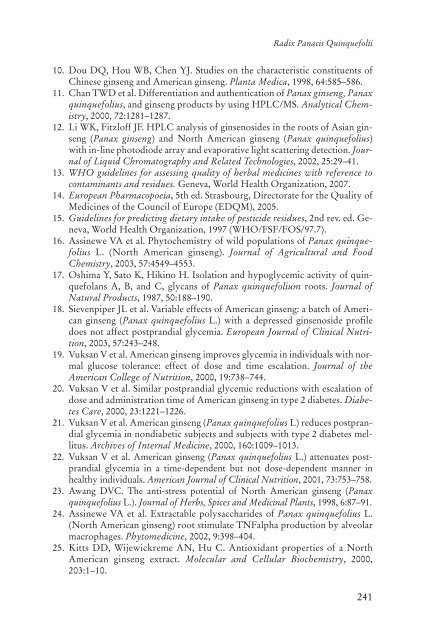WHO monographs on selected medicinal plants - travolekar.ru
WHO monographs on selected medicinal plants - travolekar.ru WHO monographs on selected medicinal plants - travolekar.ru
Radix Panacis Quinquefolii 10. Dou DQ, Hou WB, Chen YJ. Studies on the characteristic constituents of Chinese ginseng and American ginseng. Planta Medica, 1998, 64:585–586. 11. Chan TWD et al. Differentiation and authentication of Panax ginseng, Panax quinquefolius, and ginseng products by using HPLC/MS. Analytical Chemistry, 2000, 72:1281–1287. 12. Li WK, Fitzloff JF. HPLC analysis of ginsenosides in the roots of Asian ginseng (Panax ginseng) and North American ginseng (Panax quinquefolius) with in-line photodiode array and evaporative light scattering detection. Journal of Liquid Chromatography and Related Technologies, 2002, 25:29–41. 13.
- Page 198 and 199: WHO monogr
- Page 200 and 201: Fructus Momordicae Definition Fruct
- Page 202 and 203: WHO monogr
- Page 204 and 205: WHO monogr
- Page 206 and 207: WHO monogr
- Page 208 and 209: WHO monogr
- Page 210 and 211: WHO monogr
- Page 212 and 213: WHO monogr
- Page 214 and 215: WHO monogr
- Page 216 and 217: WHO monogr
- Page 218 and 219: Fructus Myrtilli Definition Fructus
- Page 220 and 221: WHO monogr
- Page 222 and 223: WHO monogr
- Page 224 and 225: WHO monogr
- Page 226 and 227: WHO monogr
- Page 228 and 229: WHO monogr
- Page 230 and 231: WHO monogr
- Page 232 and 233: WHO monogr
- Page 234 and 235: Radix Panacis Quinquefolii Definiti
- Page 236 and 237: WHO monogr
- Page 238 and 239: WHO monogr
- Page 240 and 241: WHO monogr
- Page 242 and 243: WHO monogr
- Page 244 and 245: WHO monogr
- Page 246 and 247: WHO monogr
- Page 250 and 251: WHO monogr
- Page 252 and 253: Cortex Phellodendron Definition Cor
- Page 254 and 255: WHO monogr
- Page 256 and 257: WHO monogr
- Page 258 and 259: WHO monogr
- Page 260 and 261: WHO monogr
- Page 262 and 263: WHO monogr
- Page 264 and 265: WHO monogr
- Page 266 and 267: Rhizoma Picrorhizae Definition Rhiz
- Page 268 and 269: WHO monogr
- Page 270 and 271: WHO monogr
- Page 272 and 273: WHO monogr
- Page 274 and 275: WHO monogr
- Page 276 and 277: WHO monogr
- Page 278 and 279: WHO monogr
- Page 280 and 281: WHO monogr
- Page 282 and 283: WHO monogr
- Page 284 and 285: WHO monogr
- Page 286 and 287: WHO monogr
- Page 288 and 289: WHO monogr
- Page 290 and 291: WHO monogr
- Page 292 and 293: Aetheroleum Rosmarini Definition Ae
- Page 294 and 295: WHO monogr
- Page 296 and 297: WHO monogr
Radix Panacis Quinquefolii<br />
10. Dou DQ, Hou WB, Chen YJ. Studies <strong>on</strong> the characteristic c<strong>on</strong>stituents of<br />
Chinese ginseng and American ginseng. Planta Medica, 1998, 64:585–586.<br />
11. Chan TWD et al. Differentiati<strong>on</strong> and authenticati<strong>on</strong> of Panax ginseng, Panax<br />
quinquefolius, and ginseng products by using HPLC/MS. Analytical Chemistry,<br />
2000, 72:1281–1287.<br />
12. Li WK, Fitzloff JF. HPLC analysis of ginsenosides in the roots of Asian ginseng<br />
(Panax ginseng) and North American ginseng (Panax quinquefolius)<br />
with in-line photodiode array and evaporative light scattering detecti<strong>on</strong>. Journal<br />
of Liquid Chromatography and Related Technologies, 2002, 25:29–41.<br />
13. <str<strong>on</strong>g>WHO</str<strong>on</strong>g> guidelines for assessing quality of herbal medicines with reference to<br />
c<strong>on</strong>taminants and residues. Geneva, World Health Organizati<strong>on</strong>, 2007.<br />
14. European Pharmacopoeia, 5th ed. Strasbourg, Directorate for the Quality of<br />
Medicines of the Council of Europe (EDQM), 2005.<br />
15. Guidelines for predicting dietary intake of pesticide residues, 2nd rev. ed. Geneva,<br />
World Health Organizati<strong>on</strong>, 1997 (<str<strong>on</strong>g>WHO</str<strong>on</strong>g>/FSF/FOS/97.7).<br />
16. Assinewe VA et al. Phytochemistry of wild populati<strong>on</strong>s of Panax quinquefolius<br />
L. (North American ginseng). Journal of Agricultural and Food<br />
Chemistry, 2003, 57:4549–4553.<br />
17. Oshima Y, Sato K, Hikino H. Isolati<strong>on</strong> and hypoglycemic activity of quinquefolans<br />
A, B, and C, glycans of Panax quinquefolium roots. Journal of<br />
Natural Products, 1987, 50:188–190.<br />
18. Sievenpiper JL et al. Variable effects of American ginseng: a batch of American<br />
ginseng (Panax quinquefolius L.) with a depressed ginsenoside profile<br />
does not affect postprandial glycemia. European Journal of Clinical Nutriti<strong>on</strong>,<br />
2003, 57:243–248.<br />
19. Vuksan V et al. American ginseng improves glycemia in individuals with normal<br />
glucose tolerance: effect of dose and time escalati<strong>on</strong>. Journal of the<br />
American College of Nutriti<strong>on</strong>, 2000, 19:738–744.<br />
20. Vuksan V et al. Similar postprandial glycemic reducti<strong>on</strong>s with escalati<strong>on</strong> of<br />
dose and administrati<strong>on</strong> time of American ginseng in type 2 diabetes. Diabetes<br />
Care, 2000, 23:1221–1226.<br />
21. Vuksan V et al. American ginseng ( Panax quinquefolius L) reduces postprandial<br />
glycemia in n<strong>on</strong>diabetic subjects and subjects with type 2 diabetes mellitus.<br />
Archives of Internal Medicine, 2000, 160:1009–1013.<br />
22. Vuksan V et al. American ginseng ( Panax quinquefolius L.) attenuates postprandial<br />
glycemia in a time-dependent but not dose-dependent manner in<br />
healthy individuals. American Journal of Clinical Nutriti<strong>on</strong>, 2001, 73:753–758.<br />
23. Awang DVC. The anti-stress potential of North American ginseng ( Panax<br />
quinquefolius L.). Journal of Herbs, Spices and Medicinal Plants, 1998, 6:87–91.<br />
24. Assinewe VA et al. Extractable polysaccharides of Panax quinquefolius L.<br />
(North American ginseng) root stimulate TNFalpha producti<strong>on</strong> by alveolar<br />
macrophages. Phytomedicine, 2002, 9:398–404.<br />
25. Kitts DD, Wijewickreme AN, Hu C. Antioxidant properties of a North<br />
American ginseng extract. Molecular and Cellular Biochemistry, 2000,<br />
203:1–10.<br />
241



